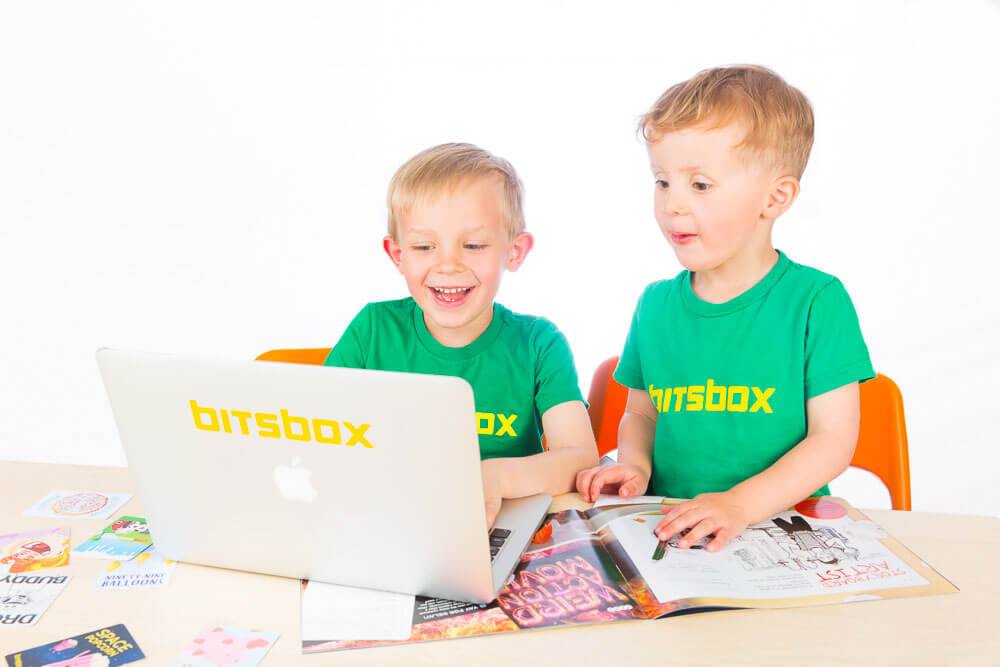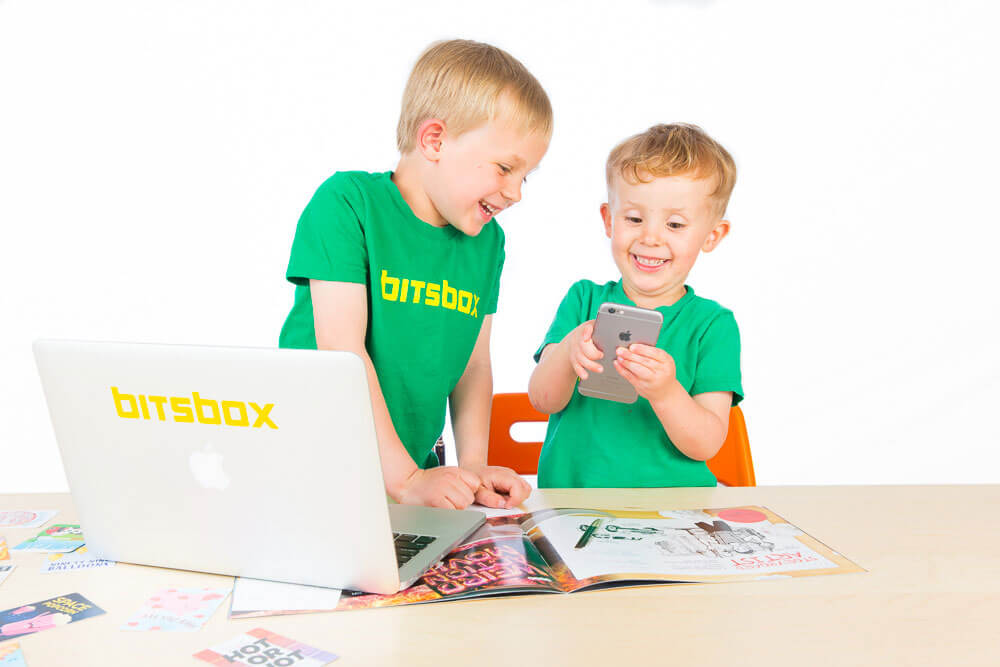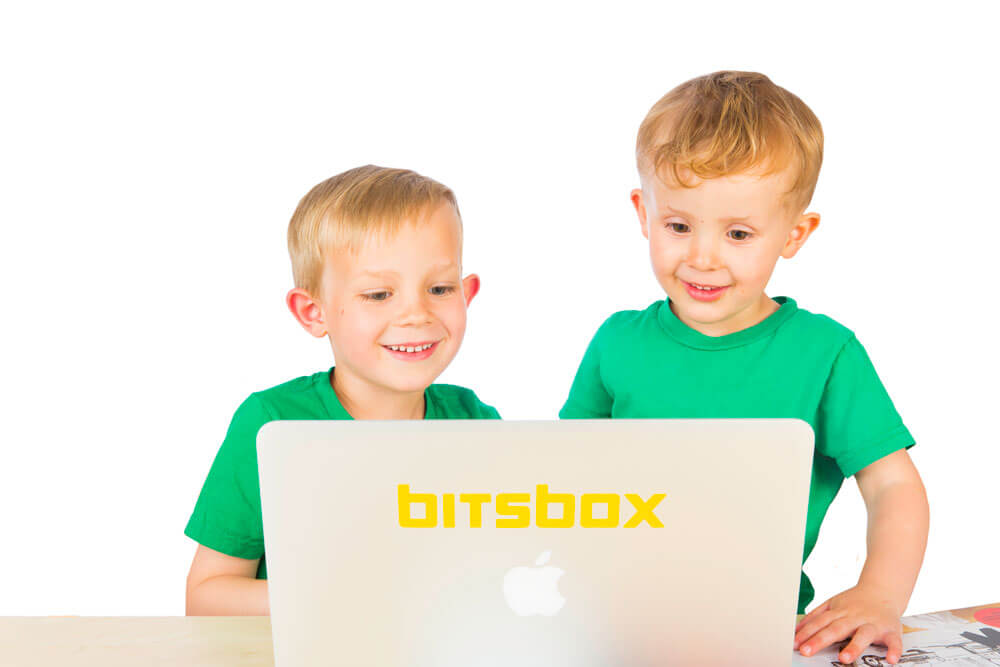Now, as brilliant as Beau may be, he doesn't have the patience nor the letter recognition necessary to sit down and build his own apps just yet. He can, however, play the apps and offer silly suggestions to change them — which he does with gusto.

Cash codes while Beau looks on in awe.
Bitsbox has become a paired activity for Cash and Beau, and when the kids code together, they rarely fight (hallelujah!) and always feed off each other.
How my kids code together
So how exactly do my kids code as a pair? Here's what typically works for them:
- Together the boys flip through the new apptivity book (or Supercards) and pick the apps that look most interesting to them.
- With Beau watching intently, Cash builds an app on the laptop, one key at a time.
- After the app is ready to play, both boys learn its functionality on the laptop screen and then quickly beg for my smartphone.
- Cash brings up the QR code on the computer, and Beau carefully hovers the phone over the screen until the scanner recognizes the code. In no time, the freshly built app is ready to play on my phone.
- Now the fun really begins. Because the mobile device displays real-time updates to the code, Cash and Beau can collaborate on how to customize the app. Sure, blasting 10 aliens is fun . . . but what if they could blast 10,000 aliens!?! Cash makes the change, and laughter ensues. And, sure, aliens are fine, but what if they could blast a doughnut?! More squeals of delight. And on it goes.

Both kids delight in testing the cah-razy changes they made to Alien Blaster.
How we helped the kids learn to code as a team
In our early Bitsboxing days, learning to code apps was an activity restricted to Cash and me. Frankly, it never occurred to me that the two kids could enjoy coding in tandem.
However, Beau was not content with being left out of the fun. After I made several failed attempts at redirecting Beau to other projects, Cash took the lead and showed his little brother how to scan and play an app. I gave little guidance as the kids developed the natural pattern of maker and tester, but in the beginning, I did provide a few prompts that led them towards harmonious coding:
- Reinforce their unique roles. Although the kids naturally slipped into the maker and tester roles, I offered positive reinforcement by reminding them of their jobs. Providing gentle structure around the process gives them a framework for understanding what they're doing. "Wow, Cash! You're doing a fantastic job coding and typing. You are Mr. Maker!” “Beau! Amazing suggestion to change the aliens to donuts — I can't wait to see what happens when Cash updates the code!"
- Redirect, redirect, redirect. The boys occasionally bickered over who got to scan the QR code or who played the app first on the tablet. When I detected a squabble coming on, I quickly redirected each of them to their respective roles. “Cash, you're so good on the trackpad—can you pull up the QR code? Can you explain to Beau what a QR code is?”
- Give them space. All the reinforcement and redirection is best done from the sidelines. I'd keep one eye on the two kids while working a mindless task nearby. Giving them the illusion of independence built confidence and ultimately meant they could truly operate independently.
How teaching our kids to code benefits our family
When my husband and I introduced our kids to coding, we didn't know much they'd enjoy the activity. However, our Bitsbox subscription and the time we invested in helping the boys start learning to code have exceeded our expectations.
Here are the top three ways coding with Bitsbox has helped our family:
- Coding has become a normalized activity. In the evening when my husband and I need a few minutes to prepare dinner, move some laundry, or (gasp) catch up with each other, we encourage the kids to find an activity to do together. The boys see coding as an option alongside more traditional activities, such as creating with Play-Doh, building a fort, or kicking around the soccer ball.
- Our kids are practicing teamwork. Through the function of their roles, they're forced to communicate and respect each other's opinions. These communication skills will take them far in life!
- Coding is fun. Both boys are quickly developing positive associations with coding and identify as coders. This foundation of fun and positivity will ensure they're comfortable continuing to pursue computer science if they want. We're removing a barrier of fear and discomfort surrounding the idea of “code” at an early age.
When the boys create an app together, the whole process makes for at least 30 minutes of sibling peace. As Beau gets older, the boys may need to adjust the roles. But for now, Cash is proud in his big-brother coder position, and Beau is delighted in his little-brother helper role.
Get out there and code!
If you have more than one child, you can introduce paired programming to your kids anytime! All you need is a Bitsbox, a computer, and a smartphone. If you only have one kid who is ready to code, invite some friends over!


